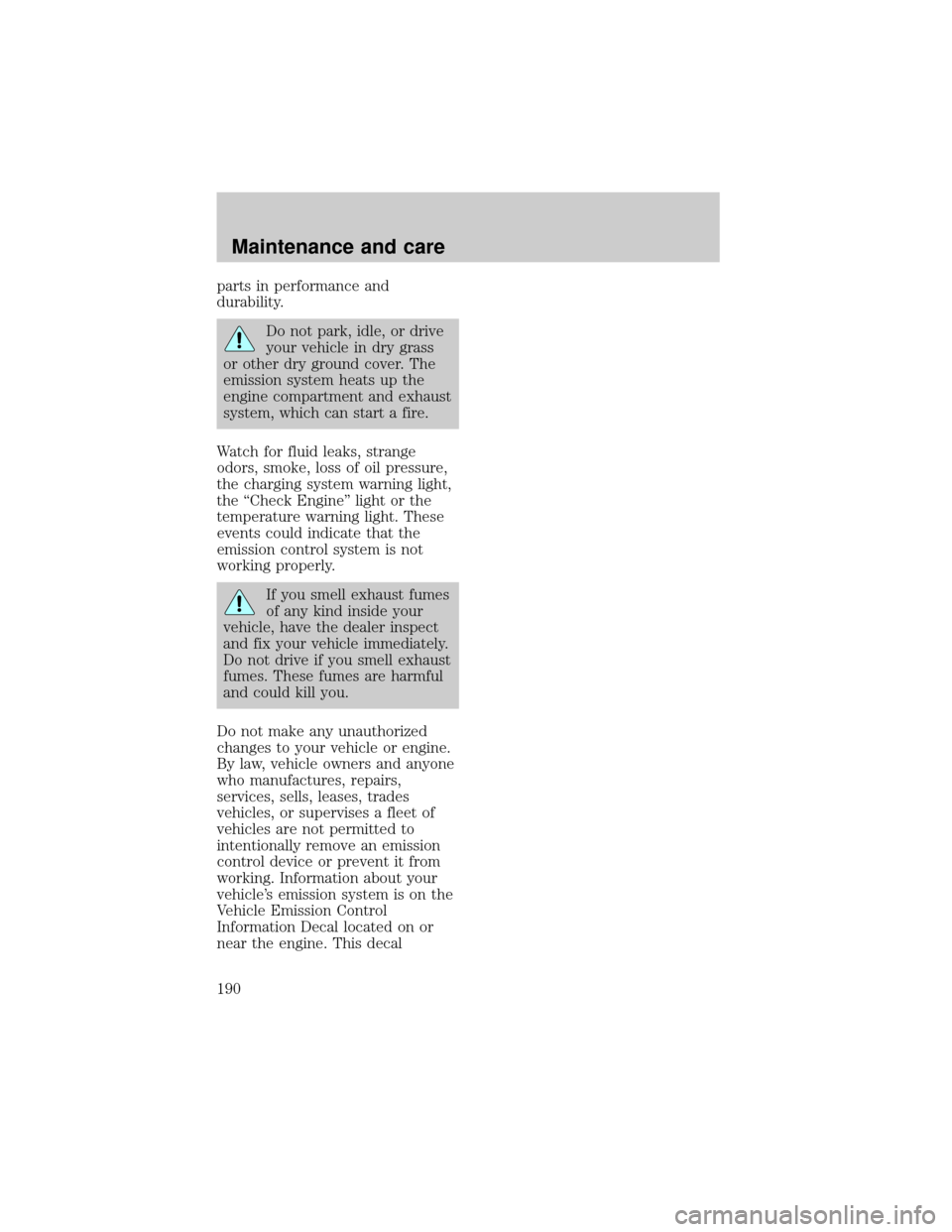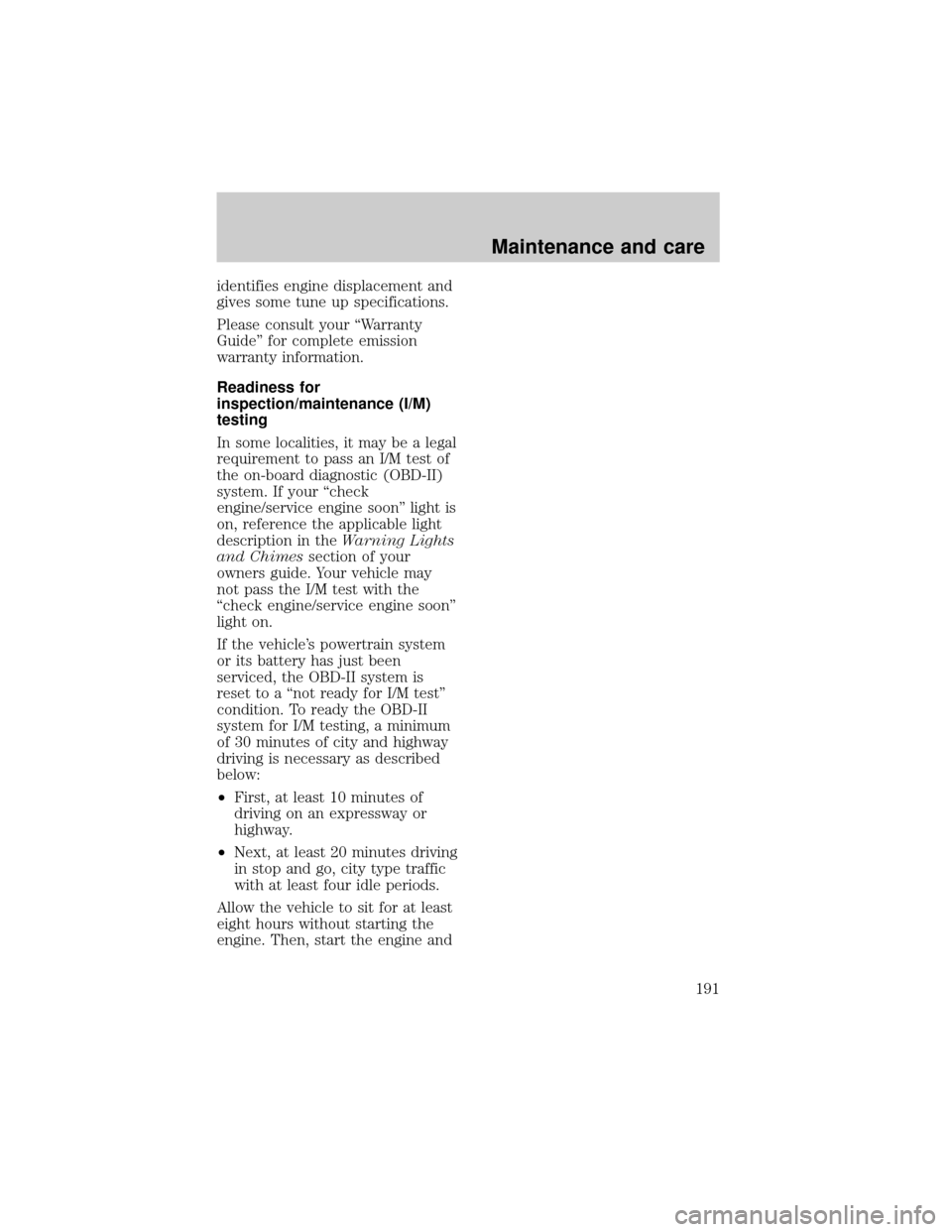1998 FORD F150 check engine
[x] Cancel search: check enginePage 172 of 219
![FORD F150 1998 10.G Owners Manual The transmission fluid should be in
this range if at room temperature
(10ÉC-35ÉC [50ÉF-95ÉF]) (see
figure to the right).
If your vehicle has been operated
for an extended period at high
speeds, in FORD F150 1998 10.G Owners Manual The transmission fluid should be in
this range if at room temperature
(10ÉC-35ÉC [50ÉF-95ÉF]) (see
figure to the right).
If your vehicle has been operated
for an extended period at high
speeds, in](/manual-img/11/5017/w960_5017-171.png)
The transmission fluid should be in
this range if at room temperature
(10ÉC-35ÉC [50ÉF-95ÉF]) (see
figure to the right).
If your vehicle has been operated
for an extended period at high
speeds, in city traffic during hot
weather or pulling a trailer, the
vehicle should be turned off for
about 30 minutes to allow the fluid
to cool before checking.
1. Park the vehicle on a level
surface and engage the parking
brake.
2. With the parking brake engaged
and your foot on the brake pedal,
start the engine and move the
gearshift lever through all of the
gear ranges. Allow sufficient time
for each gear to engage.
3. Latch the gearshift lever in P
(Park) and leave the engine
running.
4. Remove the dipstick, wiping it
clean with a clean, dry lint free
rag.
5. Install the dipstick making sure
it is fully seated in the filler tube.
6. Remove the dipstick and inspect
the fluid level. The fluid level
should be in the crosshatched area
on the dipstick.DON'T ADD IF IN CROSSHATCHED AREA • CHECK WHEN HOT IDLING IN PARK
ADD COLD HOT DO NOT ADD
Maintenance and care
172
Page 176 of 219

the electrolyte in each cell up to
the ªlevelº indicator. Do not overfill
the battery cells.
If the electrolyte level in the
battery is low, you can add plain
tap water to the battery, as long as
you do not use hard water (water
with a high alkali content). If
possible, however, try to only fill
the battery cells with distilled
water. If the battery needs water
often, have the charging system
checked.
For longer, trouble-free operation,
keep the top of the battery clean
and dry. Also, make certain the
battery cables are always tightly
fastened to the battery terminals.
If you see any corrosion on the
battery or terminals, remove the
cables from the terminal(s) and
clean with a wire brush. You can
neutralize the acid with a solution
of baking soda and water. Reinstall
the cables when you are done
cleaning them, and apply a small
quantity of grease to the top of
each battery terminal to help
prevent corrosion.
If your battery has a
cover/shield, make sure it is
reinstalled after the battery is
replaced.
Because your vehicle's engine is
electronically controlled by a
computer, some control conditions
are maintained by power from the
battery. When the battery is
disconnected or a new battery is
installed, the engine must relearn
Maintenance and care
176
Page 177 of 219

its idle conditions before your
vehicle will drive properly. To
begin this process:
1. Put the gearshift in P (Park)
(automatic transmissions) or the
neutral position (manual
transmissions), turn off all
accessories and start the vehicle.
2. Let the engine idle for at least
one minute.
3. The relearning process will
automatically complete as you
drive the vehicle.
²If you do not allow the engine to
relearn its idle, the idle quality
of your vehicle may be adversely
affected until the idle is
eventually relearned.
²If the battery has been
disconnected or a new battery
has been installed, the clock and
the preset radio stations must
be reset once the battery is
reconnected.
²Always dispose of automotive
batteries in a responsible
manner. Follow your
communities standards for
disposal. Call your local
recycling center to find out
more about recycling automotive
batteries.
WINDSHIELD WIPER BLADES
Check the wiper blades at least
twice a year or when they seem
less effective. Substances such as
tree sap and some hot wax
Maintenance and care
177
Page 190 of 219

parts in performance and
durability.
Do not park, idle, or drive
your vehicle in dry grass
or other dry ground cover. The
emission system heats up the
engine compartment and exhaust
system, which can start a fire.
Watch for fluid leaks, strange
odors, smoke, loss of oil pressure,
the charging system warning light,
the ªCheck Engineº light or the
temperature warning light. These
events could indicate that the
emission control system is not
working properly.
If you smell exhaust fumes
of any kind inside your
vehicle, have the dealer inspect
and fix your vehicle immediately.
Do not drive if you smell exhaust
fumes. These fumes are harmful
and could kill you.
Do not make any unauthorized
changes to your vehicle or engine.
By law, vehicle owners and anyone
who manufactures, repairs,
services, sells, leases, trades
vehicles, or supervises a fleet of
vehicles are not permitted to
intentionally remove an emission
control device or prevent it from
working. Information about your
vehicle's emission system is on the
Vehicle Emission Control
Information Decal located on or
near the engine. This decal
Maintenance and care
190
Page 191 of 219

identifies engine displacement and
gives some tune up specifications.
Please consult your ªWarranty
Guideº for complete emission
warranty information.
Readiness for
inspection/maintenance (I/M)
testing
In some localities, it may be a legal
requirement to pass an I/M test of
the on-board diagnostic (OBD-II)
system. If your ªcheck
engine/service engine soonº light is
on, reference the applicable light
description in theWarning Lights
and Chimessection of your
owners guide. Your vehicle may
not pass the I/M test with the
ªcheck engine/service engine soonº
light on.
If the vehicle's powertrain system
or its battery has just been
serviced, the OBD-II system is
reset to a ªnot ready for I/M testº
condition. To ready the OBD-II
system for I/M testing, a minimum
of 30 minutes of city and highway
driving is necessary as described
below:
²First, at least 10 minutes of
driving on an expressway or
highway.
²Next, at least 20 minutes driving
in stop and go, city type traffic
with at least four idle periods.
Allow the vehicle to sit for at least
eight hours without starting the
engine. Then, start the engine and
Maintenance and care
191
Page 192 of 219

complete the above driving cycle.
The engine must warm up to its
normal operating temperature.
Once started, do not turn off the
engine until the above driving
cycle is complete.
EXTERIOR BULBS
Replacing exterior bulbs
Check the operation of the
following lamps frequently:
²headlamps
²foglamps (if equipped)
²high-mount brakelamp
²brakelamps
²turn signals
²license plate lamp
²tail lamps
²back-up lamps
Do not remove lamp bulbs unless
they can be replaced immediately
with new ones. If a bulb is
removed for an extended period of
time, contaminants may enter the
lamp housings and affect lamp
performance.
Maintenance and care
192
Page 216 of 219

Air bag supplemental restraint
system ..........................................60
and child safety seats ..............61
description ................................60
disposal ......................................64
indicator light ...........................63
passenger air bag ...........62,65,66
Air conditioning
manual heating and air
conditioning system .......22,23,26
Air suspension
description ................................87
warning light .............................11
Ambulance packages ....................3
Anti-lock brake system (ABS)
description ................................84
Anti-theft system ........................40
Battery .......................................175
voltage gauge ............................16
Brake fluid
checking and adding ..............162
Brakes ..........................................83
anti-lock .....................................83
anti-lock brake system (ABS)
warning light .............................84
fluid, checking and adding ....162
Brake-shift interlock ...................88
Break-in period .............................2
Bulbs, replacing ........................192
headlamps ...............................193
specifications ..........................197
Changing a tire .........................141
Child safety seats ........................70
Chime
headlamps on ............................12
Cleaning your vehicle ...............198
engine compartment ..............200
fabric ........................................201
instrument panel ....................201
plastic parts ............................201
safety belts ..............................202
tail lamps .................................201washing ....................................198
waxing .....................................199
wheels ......................................199
Clutch
fluid ..........................................163
Controls .......................................19
Daytime running light system ...17
Driving under special
conditions ..................................105
high water ...............................105
slippery roads ..................106,107
Emission control system ..........189
Engine ........................................210
check engine temperature
warning, message
center ...............................155,156
service points ..........................155
Engine block heater ...................80
Engine coolant
checking and adding .......164,165
disposal ....................................166
refill capacities ........................167
Engine oil ...........................156,160
changing oil and oil filter .......161
checking and
adding ........................156,158,160
Exhaust fumes ............................81
Fail safe cooling ........................168
Foglamps ............................196,197
Four-Wheel Drive vehicles .........98
control trac ........................19,102
indicator light ...........................99
lever operated electric shift ....99
Fuel
calculating fuel economy .......188
improving fuel economy ........130
octane rating ...........................187
quality ......................................187
safety information relating to
automotive fuels .....................184
Fuel gauge ...................................13
Fuel pump shut-off switch .......131
Index
216
Page 217 of 219

Fuse panels
instrument panel ....................133
power distribution box ...........138
Fuses ...................................132,133
Gauges, Mechanical ....................13
engine coolant temperature
gauge .........................................14
Hazard flashers .........................131
Headlamps
autolamp system .......................18
flashing ......................................35
high beam .................................35
turning on and off ....................17
Heating ........................................20
High beams
indicator light ...........................10
Hood
release lever ............................154
Ignition
positions of the ignition ...........27
removing the key ......................98
Instrument panel
lighting up panel and
interior .......................................18
Jump-starting your
vehicle .................................147,149
attaching cables ......................148
disconnecting cables ..............149
Keyless entry system
autolock .....................................44
Keys
key in ignition chime ...............12
Lamps
interior lamps ...........................36
map lamps .................................36
parking lamps .........................195
Lights, warning and indicator
air bag ..........................................8
anti-lock brakes (ABS) ..............9
anti-theft ...................................10
brake ............................................9
charging system ........................10check engine ............................6,7
door ajar ....................................11
engine oil pressure ...................10
four-wheel drive ........................11
fuel reset ................................6,12
safety belt ...................................9
turn signal indicator ...................9
Load limits
trailer towing ..........................110
Lubricant specifications ....205,208
Manual transmission ...................92
shift speeds .....................94,96,97
Mirrors
side view mirrors (power) .......38
Odometer .....................................15
Off road driving, 4-wheel drive 104
Overdrive ................................35,36
Panic alarm feature, remote
entry system ................................43
Parking brake ..............................85
Parts (see Motorcraft parts) ....205
Power door locks ........................38
Power steering
fluid, checking and adding ....169
Recreational towing, all wheels
on the ground ...........................123
Relays ........................................132
Remote entry system .................42
illuminated entry ......................47
locking/unlocking doors ...........43
replacement/additional
transmitters ...............................46
replacing the batteries .............45
Reporting safety defects ..........215
Safety restraints
automatic locking mode
(retractor) .......................54,55,56
extension assembly ..................57
for children ...............................68
lap and shoulder belts ........53,54
maintenance ..............................58
proper use .................................51
Index
217